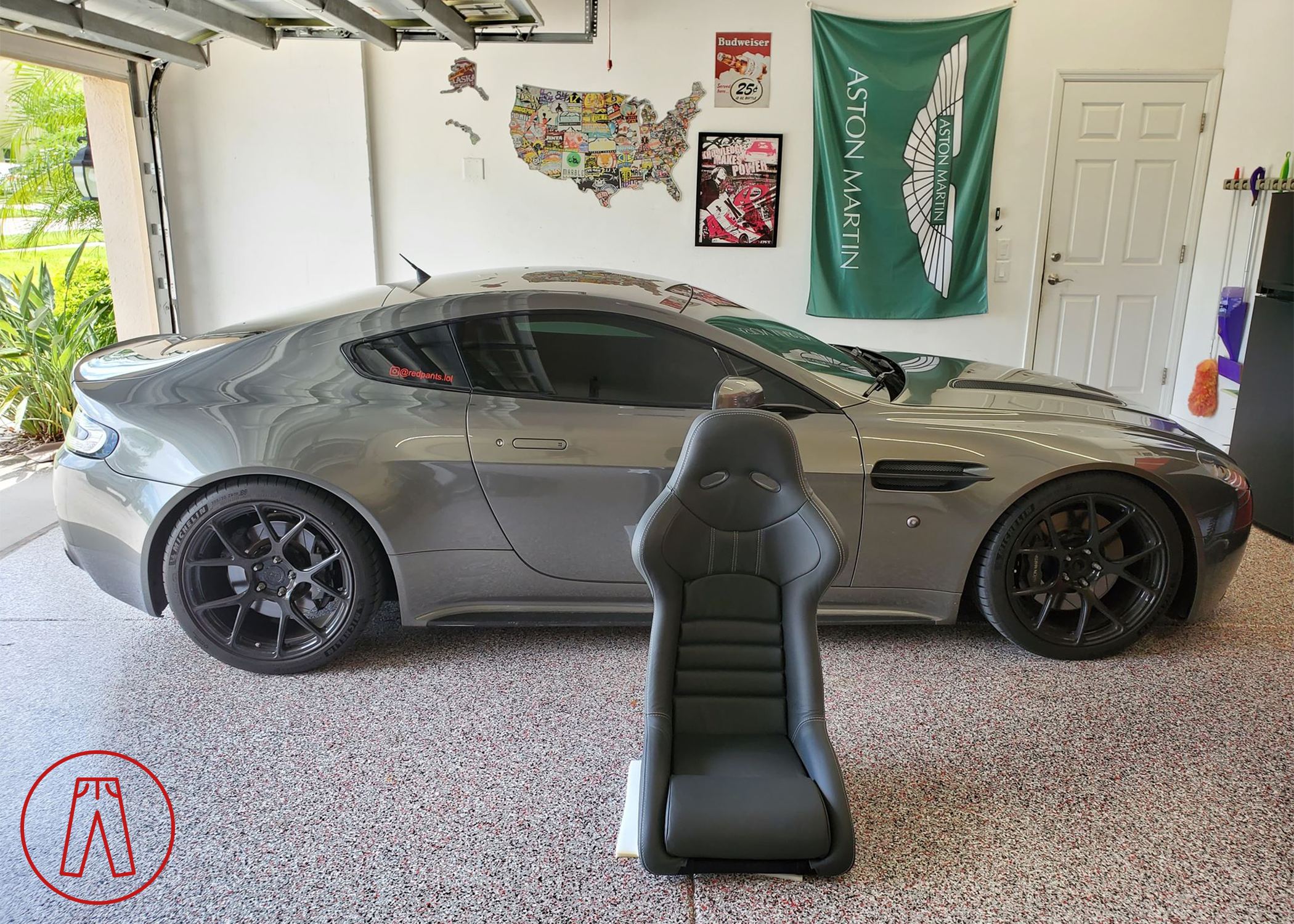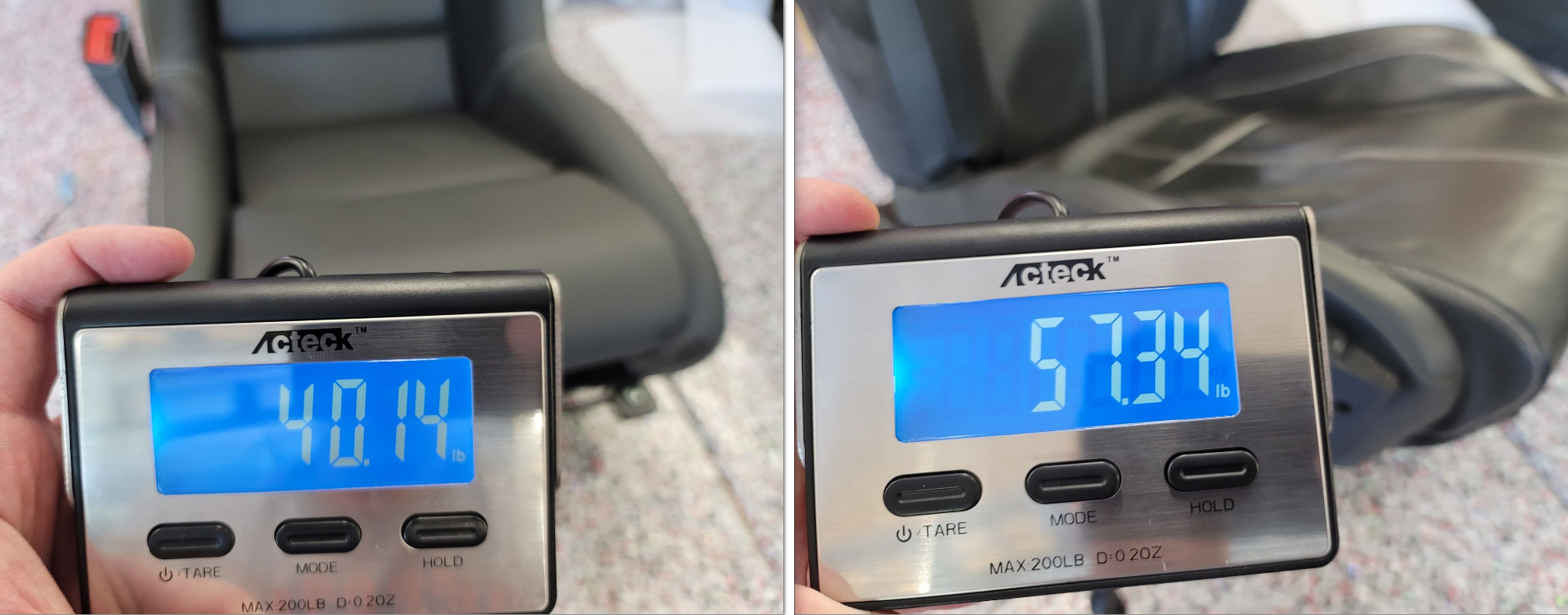
Seats Aren’t That Simple
This Article is based on a blog post from the original Redpants website. It was first posted on May 17, 2016. I’ve updated and expanded it quite a bit since then.
I first wrote a Blog Post for my original Redpants website about how I was installing a Recaro Profi SPG seat in my grey 2007 Aston Martin V8 Vantage, and detailed some of the complications I encountered. I’ve been slowly moving things over from my old website to this [new] one and came across the original Blog Post about the old Recaro that never went any further than a test-fitting. Here it is.
Although I had just about everything needed to install the seat, I never actually did. A bit of background is in order before we continue.
Previously, at Redpants…
There are plenty of people that don’t like the idea of a fixed-back seat in a car. People want adjustability and swapping out seats for one that aren’t adjustable is counter-intuitive. My counter-argument is always this: How often do you change the position of your seat? Once you have it where you want it, do you ever move it? How often do you let someone else drive your car that an adjustable seat becomes a true requirement, compared to the “guest” driver just managing your seating position for that brief period of usage? The vast majority of the time, the responses are, “Well… almost never.”
So, for most people, the idea of having a fixed-position seat is actually more intimidating than the reality of living with it. But in practice, it isn’t really an issue so long as you get a seat you like. For example, I had a Recaro Pole Position that was hard-mounted in the 2005 Subaru WRX STi that I used to have. And by “hard-mounted,” I mean it was bolted directly to the floor. There was zero adjustment. It didn’t even have sliders.
The seating position in that car was fantastic. I put it exactly where I wanted it, and there it stayed. The space between the seat and the transmission tunnel was wide enough that I could easily get to the seat belt receiver and continue using the factory 3-point seat belt, although the belt was a tiny bit higher over my lap than I would have liked.
Having space between the seat and transmission tunnel is what ultimately made the seat usable in that car, and is why a similar seat wouldn’t have worked so well in my Aston Martin.
Testing the Recaro Profi SPG
Since I loved the Pole Position in my STi, and Recaro was the original equipment manufacturer (OEM) of the seats used by Aston Martin, I chose another Recaro for my V8 Vantage - this time, the Profi SPG. I ordered the seat, side mounts, and sliders to do some test-fitting, knowing that I couldn’t complete the installation without the last piece, the base plate that would bolt to the floor of the car itself. Aside from being able to complete the installation just yet without the base plate, I realized that I wouldn’t actually want to finish it.
The main issue was that, frankly, I wasn’t satisfied with the seat for my intended use in this car.
To be more specific, I’m very particular about how I modify cars. It’s a lesson I learned early on when I was overly-aggressive with the modifications I did to a 1993 Mazda RX7 (FD3S) that I had ages ago. Simply put, I ruined the car and hated driving it because I modified it in ways that didn’t work for how I would be driving it. Ever chucked the air conditioning out of a car you drove around Georgia in the summer? I did, and it was fucking terrible. Lesson learned.
The basic issue I had with the Profi SPG is that its bolsters at the hips were too tall and wouldn’t comfortably allow the use of the factory 3-point seat belt. Unlike the situation I had in my STi, the space between the seat and center tunnel was very tight so it was difficult to get the seat belt buckled and unbuckled. The other option was to use an extender to position the seat belt receiver higher, but then the belt would be much too high over my lap. The better way to route the belt would be to pass it through the holes in the hip bolsters, but that meant uneven routing on the receiver side (going over the top of the bolster), or using the extension to put the receiver on the inner side of the bolster (not very comfortable having a receiver dig into your hip in an already-tight seat).
So, I scrapped the idea for a few years and eventually sold the Recaro.
Picking the right seat
My V8 Vantage is one of the most thoroughly-modified Astons on the planet and I’ve put a lot of time and thought into considering the pros and cons of everything I do with the car. For the seats, I realized during the test-fitting that I wouldn’t be happy with the Recaro Profi SPG. Don’t get me wrong, it’s a fantastic seat, but it just didn’t suit my needs and intentions for the car.
The direction I have for this car is to make it a track car that’s perfectly fine on the streets. Think, street-legal GT4 race car. I’d originally planned to put a high-revving race engine in this car and focus on response and precision, while supercharging my red 2007 V8 Vantage and adding luxury features to that car. All the plans converged into my grey V8 Vantage when I sold my red one - I supercharged a race engine and built the car for precision and response while also adding luxury features… With that came merging the idea of a racing seat with luxury appointments.
All of that taken into consideration, a key aspect I’d focus on would be the seat’s comfort and utility on a daily basis, regardless of whether I’m doing a track day or going to a black tie event. In came the Cobra Nogaro.
The Cobra Nogaro fit the bill in every way: It was a comfortable bucket seat, allowed the use of the original 3-point seat belt, could be wrapped in OEM leather, and the fiberglass shell option kept costs reasonable compared to a carbon fiber seat (although the OEM leather certainly made it expensive in the end). A kicker is that Cobra is a British company that makes everything in-house so these seats are more British than Aston’s own seats, which were made by Recaro in Germany!
I had my seats wrapped in OEM Phantom Grey leather to match my original interior and an added touch was having the seat shells painted in OEM Mercury Silver to match the body of my car… not that you can really tell.
Low hip bolsters were what immediately drew me to these seats as they seemed like they’d allow easy access to the factory seat belt receiver. The low bolsters would also make ingress and egress much easier, especially with the fairly-tight cabin of the V8 Vantage. After installing the seats, both assumptions proved to be absolutely true and made me completely certain that I’d made the right choice.
You can see in the picture above how the hip bolster is low enough to give completely unfettered access to the seat belt receiver, and yes they do still provide plenty of lateral support during hard corners. I was a bit worried about comfort during long drives but that proved to be a non-issue even during my massive road trip across the US.
Being a weight loss junkie, I knew this would help me reach my lightweight goals. The pic below shows a comparison but the Cobra weighs more than it would as it has the seat belt receiver attached while the factory seat did not when I was weighing them (woops). So, the weight difference is realistically a little over 18 lbs (8.2 kg) per seat.
More weight could be dropped using the carbon-shelled version, but I’m poor.
The drawbacks of fixed seatbacks
The seats weren’t quite perfect, though. I did find the back a little deep and the shoulders bit narrow. The cushions in the middle and bottom are held in place by velcro, so pulling them off and adding a layer between the shell and cushions does a great job of fixing both these “complaints” to make the seat far better for my specific body size and shape.
I also originally installed the seats using the optional low-rise mounts. I didn’t want to use them but the Cobra distributor insisted and I eventually relented, and promptly regretted not sticking to my guns. The seats being so low made them extremely difficult to slide back-and-forth as the bottoms would drag on the floor carpeting. The seat position was also too low for my liking - I’m only 5’ 7” (170cm) so I don’t need the seat to be lower than the factory seat would go (although that’s something some of you taller folk would appreciate). Swapping out the low-rise side mounts for the standard ones made things right for me.
This “body fitment” bit is one of the most difficult parts when it comes to picking out a seat. The only sure-fire way to know you’ll like a seat is to try it out, but being able to do that is extremely hard unless you just so happen to live next to a shop that has some on display or know people locally with the seats you want to try. Keep in mind that all seats fit differently and do what you can do minimize the risk of getting something that doesn’t work for you.
An intrinsic downside to the seats (or any like them) is that the fixed-back shells don’t allow the seats to fold forward. If you work on your car a lot, like I do, or if you use the parcel shelf behind the seats a lot, like I do, then you can run into some annoying situations getting behind the seats, like I do.
Lastly, I do indeed have a warning light. The factory seats each have a side-impact air bag in the outer side bolster. Removing these (or just disconnecting them) will trigger a warning light. That’s easy to trick with a resistor, but the passenger seat in US-market cars has an extra trick up its sleeve: a set of sensors to detect a passenger occupant. It should be very simple to clear the warning by using an AMDS and tweaking the car’s config file.
Final thoughts
Fixed-back seats aren’t for everyone and can be difficult to choose for those of us that do prefer them. Out of the box, the Cobra Nogaro needed a bit of tweaking to get it just right for my body size but that wasn’t difficult to do. Having them done in OEM leather was very costly but well worth the expense to not only get a perfect match for my original interior, but also refresh the cabin by replacing the old, worn-out seats with new ones.
While it can be a hassle not being able to fold the seats forward, it’s a trade-off I don’t mind too much most of the time. I’ll say that this is the biggest drawback for the seats given how I use my car and how often I put things on the parcel shelf behind the seats (especially a folding chair for events, which fits there perfectly but now is a huge pain to get in and out from behind the seats. Getting the warning light from the passenger seat sorted will happen eventually, I just haven’t gotten around to that yet so I’m ignoring it and carrying on enjoying my awesome seats.
The Cobra Nogaro strikes the perfect balance between track-day support and daily comfort. They’re definitely not for everyone, but I personally wouldn’t go back to factory seats. If you’re interested in a set for yourself, email me or use my Contact page and I’m happy to help!











